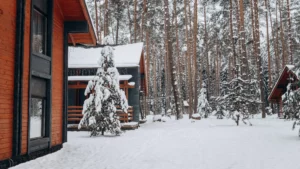23 Tips from 2023 for Living and Driving in the Mountains:
Living in the Mountains

1. Altitude Adjustment: Take time to acclimate to higher altitudes gradually to avoid altitude sickness. Drinking lots of water is one tip to help reduce the effects of the altitude.
2. Weather Preparedness: Mountain weather can be unpredictable. Be ready for sudden changes, and keep essentials like a flashlight, extra clothing, and blankets.
3. Wildlife Awareness: Learn about local wildlife and take precautions to avoid encounters, especially when hiking or spending time outdoors. Don’t feed the bears or other wildlife. Don’t leave your cars unlocked or food/trash inside…. Bears will come
4. Emergency Supplies: Keep a well-stocked emergency kit at home, including first aid supplies, non-perishable food, water, and medications.
5. Home Heating Ensure your home’s heating system is efficient and prepared for colder temperatures at higher altitudes. When leaving your home for long periods of time winterize your home …. the power may go out and if you have no heat your plumbing pipes may burst.
6. Home Power/Stay Cozy: Wifi and power may go out – make sure you have a back up light source and a good book and games to play. Generators are an option for essential power backup.
7. Vehicle Winterization: If you experience snowy conditions, prepare your vehicle for winter by equipping it with snow tires, chains, and antifreeze. Make sure you have tires appropriate for the conditions you are/or will be driving in.If you elect to use chains make sure you know what axle to put your chains on.
8. Fire Safety: Understand and adhere to local fire safety regulations. Be cautious with open flames and be aware of wildfire risks.
9. Community Involvement and Neighbors: Get involved in local community activities and events to foster a sense of belonging and support. Make friends with your neighbors – they are a great resource – you can help each other out. Whether it’s a cup of sugar or a tug out of the road or someone to keep an eye on your home while you are out of town.
10. Water Conservation: Conserve water, as mountainous regions often rely on local water sources that can be affected by seasonal changes.
11. Snow Removal: Have a plan for snow removal around your property to ensure accessibility during winter months. Honda snowblowers are a necessity – electric snow throwers work on light snow in small amounts. A snow removal contract is not optional. You may need to hire someone to shovel your roof
Driving in the Mountains:

12. Brake Carefully: Use your brakes judiciously, especially on steep descents, to avoid overheating.
13. Low Gears for Descents: Use lower gears when descending steep inclines to reduce strain on your brakes.
14. Fuel Up: Keep your gas tank at least half full, as gas stations may be sparse in remote mountain areas. Charge up. EV batteries don’t last as long in cold and extreme environments.
15. Watch for Wildlife: Be vigilant for wildlife on the roads, especially during dawn and dusk when animals are more active. Deer like to hang near the side of the roads in the winter where snow removal equipment has left salting debris.
16. Sudden Weather Changes: Be prepared for sudden weather changes, and carry snow chains if traveling in snowy conditions. Sometimes the major highways will close because of weather or an accident. – Keep an eye on social media – Truckee chp Facebook page of CalTrans App or NDOT app for up to date road conditions.
17. Steep Grade Caution: Be cautious on steep grades, both uphill and downhill, and be aware of your vehicle’s weight limits.
18. Reduce Speed: Adhere to speed limits and adjust your speed based on road conditions.
19. Cell Service Check: Be aware of areas with limited or no cell service. Inform someone about your travel plans in remote regions.
20. Emergency Kit in Vehicle: Keep an emergency kit in your vehicle, including a flashlight, blankets, water, non-perishable snacks ( don’t leave in the vehicle overnight -see wildlife above). shovel, gloves, an extra pair of clothes.
21. Map Familiarity: Familiarize yourself with the area through maps or navigation systems, as GPS signals can be unreliable in mountainous terrain. Be aware of your Waze and other app directions – They have been known to direct people to closed roads.. Sometimes it is better to stay on the main road in traffic.
22. Getting Around: Just because you have AWD or 4WD doesn’t mean you can drive on any road. Sometimes the major highways will close because of weather or an accident. – Keep an eye on social media – Truckee chp Facebook page of CalTrans App or NDOT app for up to date road conditions. The town of Truckee webpage will give you an idea when the road snow removal equipment is. Parking on the side of the road is not permitted between November 1 and May 1.
23. Patience is a Virtue: Sometimes staying home is the best and safest place to be. It’s either snow season or road construction season on mountain roads. Be prepared for delays.


Leave a Reply